LAB REPORT
Science and Technology Making Headlines
Feb. 9, 2024

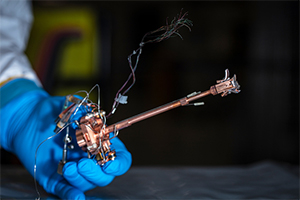
The spent target assembly from LLNL’s first achievement on ignition on Dec. 5, 2022, which is reported in the cover article of the Feb. 5, 2023, issue of Physical Review Letters. Photo by Jason Laurea/LLNL.
Twice as nice
In late 2022, scientists at Lawrence Livermore National Laboratory achieved an important fusion energy milestone with their laser-powered reactor: getting more energy out than they put in.
Now, the results have cleared the peer review process, confirming the achievement.
And it gets even better. The scientists claim in a separate paper to have gotten even better results in subsequent experiments, releasing close to twice the amount of energy the system consumed.
However, as the team was quick to point out, there's still a long road to a commercial fusion reactor.
Nonetheless, they hope that by demonstrating it's possible — despite many decades of research, the feat of achieving a net energy gain had long seemed to remain perpetually elusive — the industry will be encouraged to keep trying to realize its goal of a greener future.

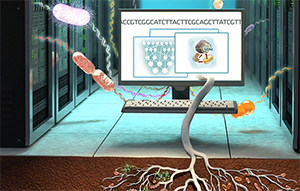
Microbe models leverage extensive genomic data to power soil carbon simulations. Illustration by Victor O. Leshyk.
Underneath it all
Research from Lawrence Berkeley National Laboratory (Berkeley Lab), Lawrence Livermore National Laboratory (LLNL), and UC Davis sheds new light on how to access the sugars locked up in plants to produce petroleum-free fuels, chemicals and medicines.
Using microbes to convert grasses, weeds, wood, and other plant residues into sustainable products will be key to achieving carbon neutrality and could even help eliminate drug shortages. But cellulose, the tough tissue that makes up a large proportion of herbaceous and woody plant bodies, is hard to break down into its composite sugars, which the microbes need to build other molecules. Only organisms that have evolved specialized enzymes, or those that host microbiomes of those organisms, are able to get sugars from cellulose-rich plant matter.
Scientists are studying how these enzymes work so that they can develop more efficient methods to convert plant waste into sweet ingredients.
At LLNL, researchers intend to employ the same approach to investigate biomolecules present in soil, plant, and animal tissues, focusing on those relevant to biosecurity applications.

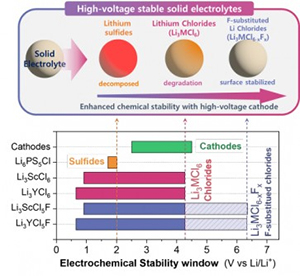
High-Voltage Stable Solid-State Electrolytes Design Strategies. Image courtesy of Korea Institute of Science and Technology.
High voltage gets stable
Researchers are actively working on non-flammable solid electrolytes as a safer alternative to liquid electrolytes commonly found in lithium-ion batteries, which are vulnerable to fires and explosions. While sulfide-based solid electrolytes exhibit excellent ionic conductivity, their chemical instability with high-voltage cathode materials necessary for high-energy-density batteries has impeded their commercial viability.
Consequently, there has been a growing interest in chloride-based solid electrolytes, which are offer stability in high-voltage conditions due to their strong bonding properties.
The Korea Institute of Science and Technology announced that a KIST-Lawrence Livermore National Laboratory joint research team led by Seungho Yu of the Energy Storage Research CenterSang Soo Han of the Computational Science Research Center and Brandon Wood of Lawrence Livermore National Laboratory (LLNL) has developed a fluorine substituted high-voltage stable chloride-based solid-state electrolyte through computational science.
LLNL is a leading national laboratory under the U.S. National Nuclear Security Administration, renowned for its excellent supercomputing facilities. KIST and LLNL have been conducting collaborative research in the field of secondary batteries in 2019.
To improve the high-voltage stability of chloride-based solid electrolyte (Li3MCl6), the research team proposed the optimal composition and design principle of chloride-based solid electrolyte (Li3MCl5F) substituted with fluorine(F), which has strong chemical bonding ability. For the proposed strategy to improve the high-voltage stability of chloride-based solid electrolytes by KIST, LLNL contributed by utilizing their cutting-edge supercomputing resources for calculations and subsequent experimental validations were conducted at KIST. The collaborative research team adopted a cost-effective and time-saving strategy, wherein computational science guides the initial material design, followed by rigorous laboratory validation.

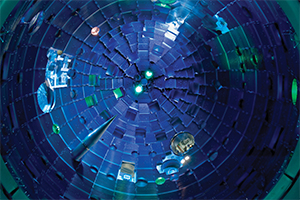
The target chamber of LLNL’s National Ignition facility where researchers achieved fusion.
Stay tuned for more to come
Scientists have confirmed that a fusion reaction in 2022 reached a historic milestone by unleashing more energy than was put into it – and subsequent trials have produced even better results, they say. The findings, now published in a series of papers, give encouragement that fusion reactors will one day create clean, plentiful energy.
Today’s nuclear power plants rely on fission reactions, where atoms are smashed apart to release energy and smaller particles works in reverse, squeezing smaller particles together into larger atoms; the same process powers our sun.
Fusion can create more energy with none of the waste involved in fission, but finding a way to contain and control this process, let alone extract energy from it, has eluded scientists and engineers for decades.
Experiments to do this using capsules of deuterium and tritium fuel bombarded with a laser – a process called inertial confinement fusion (ICF) – began at the Lawrence Livermore National Laboratory (LLNL) in 2011. The energy released was initially only a tiny fraction of the laser energy put in, but it gradually increased until an experiment on Dec. 5, 2022 finally broke more than even. That reaction put out 1.5 times the laser energy required to kickstart it.
In one paper, the Lab’s National Ignition Facility (NIF) claims that trial runs since then have yielded even greater ratios, peaking at 1.9 times the energy input on Sept. 4, 2023.
Richard Town at LLNL says the team’s checks and double-checks since the 2022 result have proved that it “wasn’t a flash in the pan,” and he believes there is still room for improvement.

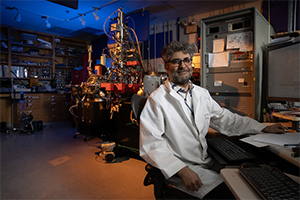
LLNL scientist Xavier Mayali used the LLNL nanoSIMS analysis instrument to quantify the flux of ammonia and urea into the cells. Photo by Blaise Douros/LLNL.
A nitrogen mystery unraveled
Ammonia-oxidizing microorganisms (AOM) play a significant role in the global nitrogen cycle. There are four types of AOM: ammonia-oxidizing archaea (AOA), beta- and gamma-proteobacterial ammonia-oxidizing bacteria (β-AOB and γ-AOB), and complete ammonia oxidizers (comammox). They are believed to compete for ammonia as their main nitrogen source. Additionally, many AOM species can use urea as an alternative energy source and nitrogen by converting it to ammonia.
But one major question that has remained unanswered for decades is how different AOM species coexist in the same environment: do they compete for ammonia or instead use other alternative compounds for their energy needs?
New research by Lawrence Livermore National Laboratory (LLNL), the University of Oklahoma and other collaborators found an answer that significantly changes the understanding of ammonia oxidation, a critical component of the global nitrogen cycle.
The study aimed to figure out why and how different types of microorganisms that play a role in ammonia oxidation can coexist without directly competing for inorganic nitrogen (ammonia). They also examined how these microorganisms use organic nitrogen (urea) instead.
More than half of these AOM lineages have adapted to using urea. However, using urea requires extra energy because it’s a more complex molecule that must be broken down into ammonia before use. The researchers wanted to understand how these microorganisms acquire and process both ammonia and urea when both are present.





